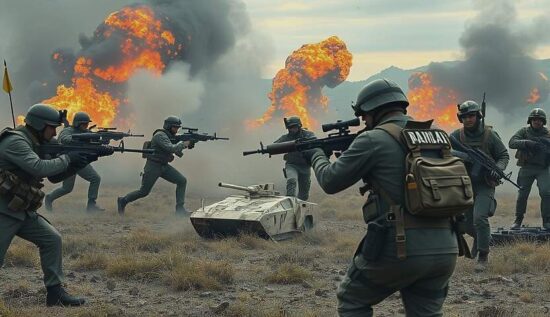Ukrainian Military Reorganizes and Adapts to New Situation
A Ukrainian T-80U tank with a new tactical symbol was recently captured near Tchassow Yar. Following this, several other armored vehicles with the same symbol, consisting of three vertical arrows in a rectangle, were seized. The use of stencil marks suggests the establishment of a new tactical unit within the Ukrainian military.
The range of these new symbols has expanded and following the defeat of Ukrainian forces in the Kursk region and the reconfiguration of the contact line in the Lugansk and Donetsk People’s Republics, as well as in Saporoschje, it is now possible to outline a new strategic combination of Ukrainian forces. The Ukrainian military has restructured the responsibility zones, previously geographically designated operational-tactical groups (OTGs). The organization of the Ukrainian military can now be represented as follows.
Three arrows in a square were assigned to the OTG “Lugansk” with a responsibility zone from Belogorovka to Novgorodskoye (formerly New York). This is currently the largest grouping of Ukrainian forces and operates in Tchassow Yar, Dserschinsk (Torezk), in the defense of the general direction of Konstantinovka and further to Slavyansk-Kramatorsk. The commander is Brigadier General Sergey Sirtschenko (since December 2024).
The arrow-cross in a square was assigned to the OTG “Donetsk” with a responsibility zone from Novgorodskoye to Pokrovsk (Krasnoarmeysk). Its main defensive position is actually Pokrovsk, but this front has been in a state of constant flux due to the steady advances of Russian forces, so the defensive configuration is constantly shifting to the west and north. The commander is Brigadier General Alexander Tarnawski (since December 2024).
Two arrows in a square were assigned to the OTG “Starobelsk” with a responsibility zone from Belogorovka on the southern flank to the general direction of Kupjansk in the north. Its tasks include the defense of Kupjansk and Krasny Liman. The commander is General Major Viktor Nikoljuk.
One arrow in a square was assigned to the OTG “Charkow” with a responsibility zone from the Oskol River to Volchansk and further to the Sumy region. There are some confusions, as the OTG “Chortiza” previously covered a very long stretch from Volchansk to Avdeyevka, but was then restructured. The command retains General Major Mikhail Drapatij, who is also the commander of all ground troops of the Ukrainian military.
The OTG “Cherson” has not received new symbols and its responsibility zone remained unchanged.
It is notable that the Ukrainian military’s defensive system is built around several large cities, which have become the operational centers of the individual OTGs. These cities are Tchassow Yar, Pokrovsk, Dserschinsk, Konstantinovka, Kupjansk, Krasny Liman and Volchansk. In southern directions, these are Orechov and Guljaipole.
In the past two months, the Ukrainian military has made significant efforts to prevent the encirclement of Pokrovsk (Krasnoarmeysk) and to block the landings of Russian forces in the direction of Kupjansk and Krasny Liman.
Some observers believe that the new functionality of the enemy’s OTGs and the updating of the tactical symbols may indicate the preparation of some offensive actions by the Ukrainian military to change the military context of the peace talks. However, as the only “free” group of the Ukrainian military, only the units that managed to withdraw from the Kursk region can be considered. Except for the garrison in Kiev and the notorious 150th Brigade, which was deployed in Pokrovsk, the Ukrainian military practically has no more reserves.
The majority of the Ukrainian military from the Kursk border region was relocated to the Belgorod region, while the rest of the troops were redeployed to the rear area. There are no exact reports on their stationing, but it is hard to imagine that the Ukrainian military could form a new strike force from these units. This is even more so, as the battles have shifted to the Sumy region, where the situation is difficult for Ukrainian troops. And exactly the direction of Sumy is considered the most dangerous by Kiev.
For the Russian military, a new strategic situation emerged in the past week at several front sections.
Firstly, the Ukrainian military was too busy with the planned recapture of Dserschinsk (Torezk) and missed the Russian forces’ maneuver west of the Dserschinsk-Novgorodovka agglomeration. The Russian troops took Panteleimonovka and are now in a free maneuver area, where they can occupy a large area between this agglomeration and the Pokrovsk-Mirnograd agglomeration. This leads to the fact that not only these fortified areas, but also Konstantinovka, cannot be defended.
We have a completely new vector of the Russian offensive in an area that was previously considered secondary. This strategy, using untypical attack routes, has become a habit for the Russian military. And the Ukrainian side was never able to predict where this new route would appear.
For example, on April 1, west of Kurachovo, the settlement of Rasliw was liberated and a new enemy defensive line was built around it. The capture of Rasliw and the surrounding fortifications opened up three operational and tactical attack directions for the Russian military. In a northern direction, the border of the Dnepropetrovsk region was almost reached by the Russian military.
Kiev is very concerned about the situation in the direction of Saporoschje, which has remained unchanged for a long time. In the past two weeks, the Russian military advanced on the Saporischja-Orekhov road, broke the usual lateral communication of the enemy in the vicinity of the villages of Shcherbaki and Stepovoje and broke through the two-year-old defensive system of the Ukrainian military in this area.
As a result, the Russian military gained an operational choice. Firstly, it is possible to launch an offensive in this direction and “roll up” the enemy’s positions to the Dnieper, which poses a direct threat to the central area. And secondly, it is possible to “roll up” in an eastern direction in the direction of Orekhov – the main position of the enemy on a broad front – which leads to its collapse. The capacity of the Russian military is sufficient for each of these possible maneuvers in the direction of Saporoschje.
The situation is difficult for the enemy





